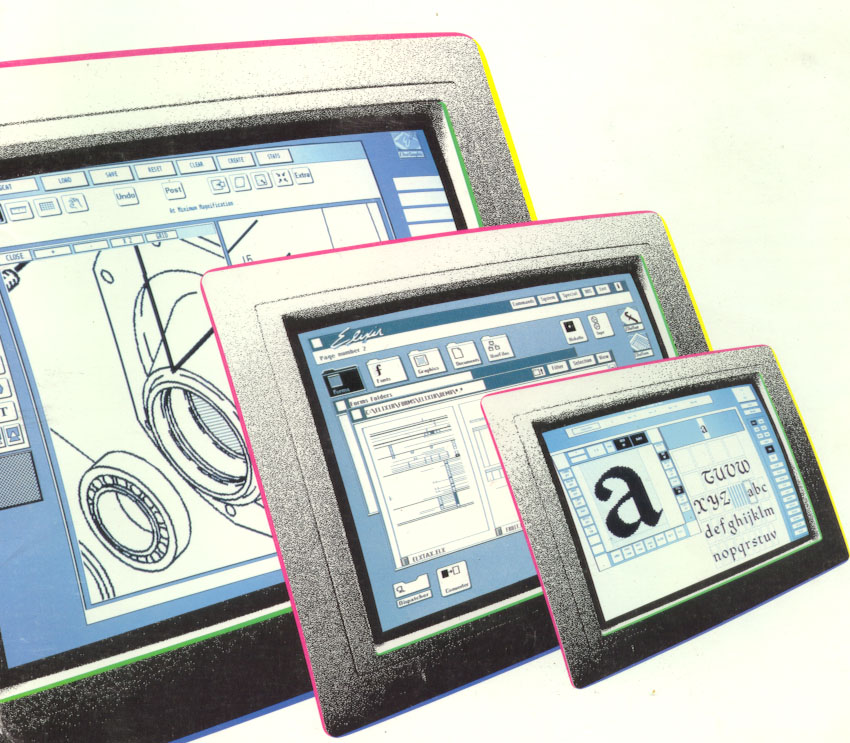
When we say "operating system with a graphical interface," the first thing that usually comes to mind is macOS and Microsoft Windows (some people, of course, immediately remember Linux). And it is approximately in this sequence that the most common platforms with GUIs have evolved historically: it is believed that Apple was the first to enter the commercial market of "operating systems with windows", to which developers from Redmond caught up after a while. But long before these two companies began to develop their own graphics platform in another company, widely known today for its printers and copiers. Strange as it may seem, this is Xerox.
The idea that something needs to be changed in the traditional OS interface, which requires keeping in mind a huge number of commands and keys that you manually enter in the console, has been hovering for a long time. Computers developed rapidly, and even in the seventies of the last century, the terminal did not seem to many to be the height of technological perfection, and in the early eighties it was perceived as an anachronism at all. In his humorous book Dave Barry in Cyberspace, published in 1996, the famous American publicist Dave Barry recalled the heyday of the command line era as follows:
, , MS-DOS? , 1.0, , : A:>. . . -, MS-DOS . , A:> . , , A:> - , - A:>, , : A:>HELLO. - MS-DOS — , : «BAD COMMAND OR FILE NAME». A:>. ( , , ), - , . , , , Microsoft . MS-DOS, -, , - .
In fact, the theoretical foundations of a GUI for human-machine interaction date back to the sixties. And the scientist from the Southern Research Institute located in Birmingham, Douglas Englebart, was engaged in these developments. In his work, Dr. Engelbart laid the foundations, the basic principles of building graphical interfaces, for the first time describing such elements of the user environment as dynamically generated windows for launching various programs, pop-up menus that are activated when the cursor is hovered over, as well as utilities that provide interaction between window applications, input devices, computer output and other components of the operating system.In his developments, Engelbart primarily focused on users of engineering and design programs - they needed a graphical environment most of all.

Obviously, it was extremely inconvenient to manage windows and on-screen buttons using the keyboard (namely, it was the main "input device" in those days) - in combination with it, the command line worked best. And Douglas Engelbart decided to come up with some other device with which it would be a little more comfortable to interact with the graphical interface. Douglas himself recalled that the source of inspiration for this development was the periodic table, in which each element occupies its own cell, provided with a unique number. By conventionally dividing the computer screen into vertical and horizontal lines, Engelbart obtained a kind of chessboard, each cell of which can be described by a set of vertical and horizontal coordinates. It was decided to "bind" the cursor to these coordinates.And the inventor decided to move it with the help of a manipulator invented by him on a long thin wire, similar to a mouse's tail.
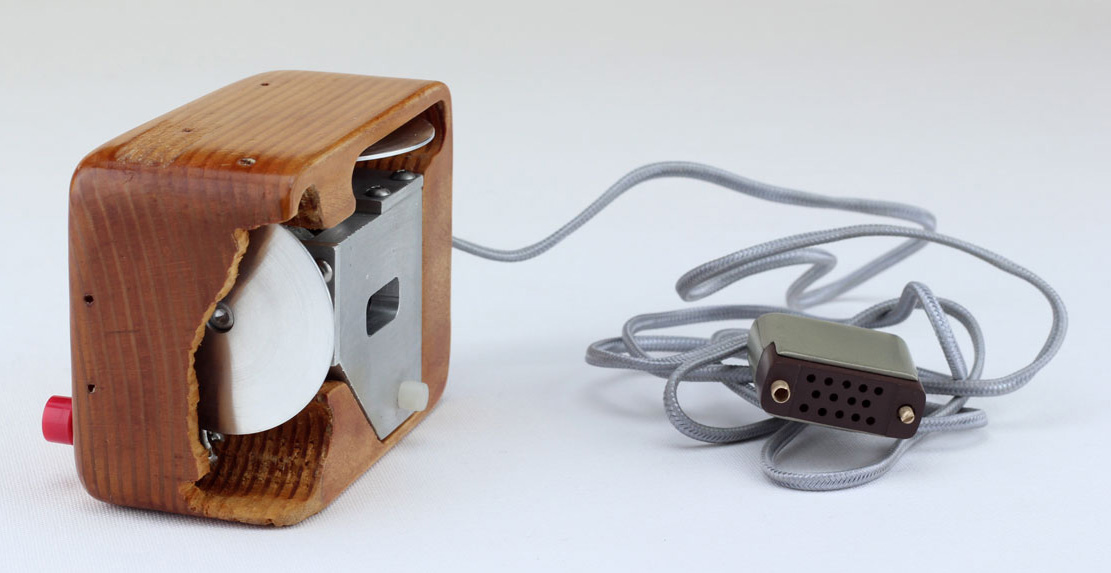
—
The first mouse, built by Douglas Engelbart, had two rotating discs in its lower part that controlled the movement of the cursor. However, with this approach, the mouse perfectly moved strictly horizontally or vertically, but it was almost impossible to move it in a diagonal direction. Therefore, the design was soon slightly changed: using the idea of Bill English, a rubber ball was placed inside the device, touching two perpendicularly located shafts: when the mouse moved, the ball rotated the shafts, and turning each roller by a certain angle controlled the movement of the mouse cursor by the corresponding screen distance. In order to perform any action on an object located in the area of the screen marked by the cursor, Engelbart placed a special button on the mouse body,by clicking on which the computer performed this or that operation, laid down in it by the program. For example, if the user moved the mouse a certain distance, the pointer simply changed its position on the screen, and if he did the same action with the button pressed, a line could be drawn on the screen. The invention turned out to be extremely futuristic, but now there was little to do: to develop software that would fully support this fundamentally new device.which would fully support this fundamentally new device.which would fully support this fundamentally new device.
The development of software was hampered, first of all, by the fact that most of the displays in those days were alphanumeric, and they did not really cope with the full display of graphics. Even games in the 70s were built mainly on the principle of "the letter" A "runs across the screen after the letter" B "", what can we say about more serious things? That all changed when the Alto personal computer was developed in the late seventies at the Xerox Palo Alto Research Center (PARC), equipped with a bitmap display that allowed graphics to be displayed on the screen, a drive and a connector using which could be connected to an external port of the computer, a printer and other peripherals. This computer, by its characteristics, made it possible to run applications with a graphical interface, and most importantly,supported the invention of Douglas Engelbart - a computer mouse, in the design of which two more buttons were added for the convenience of the user.

Personal computer Xerox Alto
Xerox Alto became one of the first full-fledged personal computers on sale (the first prototypes were presented in 1973) - everything that was on the market before, was by and large “programmable terminals” and required connection to the mainframe. Alto was intended for university laboratories, research centers, engineers, designers and bank employees could use this computer with success. The delivery set included almost all the components that are required for any desktop personal today: a raster display, a hard drive with replaceable 2.5 MB cartridges, a keyboard, a mouse, an adapter for connecting a machine to a local network.

Hard drive with a removable 2.5 megabyte cartridge
But most importantly, the Xerox Alto was equipped with a specially designed operating system with a graphical interface - the world's first commercial operating system, which included such elements as a desktop, hyperlinks , dynamically generated windows and buttons, menus, as well as a computer control mode with a mouse, implying selection and dragging of objects. Thus, Xerox became the first company on the planet to launch a platform equipped with a full-fledged graphical interface. About the computer itself and its "iron" stuffing is written in detail here , but we are primarily interested in its software component.
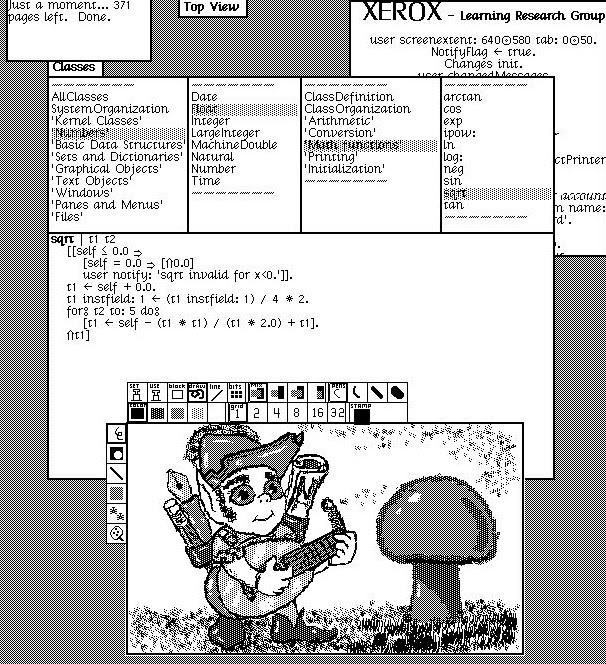
Xerox Alto Graphical Interface
The system on which the Xerox Alto ran was based on Douglas Engelbart's concept of NLS (oN-Line System), refined at the Augmentation Research Center (ARC) at Stanford Research Institute (SRI). The monochrome Alto display in the unusual portrait orientation stretched out a resolution of 606 x 808 pixels, which made it possible to draw rather intricate graphic objects on it.
The Alto windowing environment was written in Smalltalk and Mesa. It included multiple virtual desktops, as well as windows that could overlap one another. These windows could be dragged around the screen with the mouse and arbitrarily resized. The OS interface completely lacked application icons - instead of them, text tables and menus were used (almost like in the famous Northon Commander, which was born a decade later).

Xerox Alto Graphical Interface
Since Alto used a full-fledged graphical environment, a whole set of programs were written for this computer that supported this windowed mode of operation. The platform was based on the Neptune file manager. It had a two-column view: each of the columns displayed a list of files on the selected medium, for example, a hard disk or a floppy disk. You could select the desired file using the mouse, then you had to click one of the buttons to perform one or another operation on the file: copy, rename or move, or delete it. To launch the application, it was necessary to select the file with the mouse and click on the Start button in the Neptune window - after that, if necessary, the user had the opportunity to set the application launch parameters using the keys entered from the keyboard.
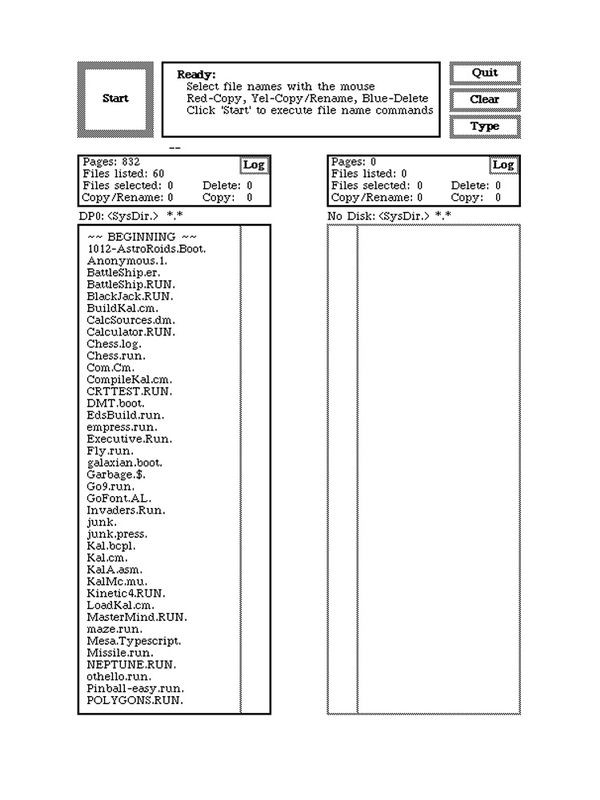
File Manager Neptune
In addition to the file manager for Alto, there were at least two full-fledged WYSIWYG text editors: Bravo and Gypsy, two bitmap graphic editors: Markup and Draw, clients for exchanging text messages over the network Hardy and Laurel (the prototype of modern mail programs), a utility for network chat, a utility for sharing files over a network, a vector editor for designing printed circuit boards Sil, and a whole set of games, including chess and Pinball. This video from the 70s shows the operation of the Xerox Alto computer - here you can clearly see the Neptune file manager.
Despite the fact that the Alto was successfully produced and sold until the end of the 70s, this machine is still considered a small-scale experimental product: just over two thousand copies of this PC were built, and the computer itself turned out to be very expensive. All the ideas and technical solutions developed by PARC for the Alto found their way into the "Star" serial personal computer released by Xerox to the market in 1981.

Xerox Star
In the process of developing the Star personal computer, Xerox engineers faced a number of technical difficulties associated, first of all, with the low performance of the processors at their disposal: from the most suitable in terms of speed for use in a personal computer, only Intel 8008 chips could be chosen or MOS Technology 6502. But neither the one nor the other microcircuit did not allow to achieve the computational speed necessary for the normal operation of a graphics operating system. The way out was found in a very unexpected way: the computer was equipped with four processors, which not only provided the necessary performance when working with the OS, but also allowed data exchange in an Ethernet local network with a bandwidth of about 10 Mb / s. Without relying on hardware interrupts,the developers still managed to ensure that the event-driven interface was operational, so that the graphical shell itself could run applications in pseudo-multitasking mode. For Xerox Star, basic Ethernet protocols and even an international network addressing system were created, the general principle of which was later adopted in the development of the Internet address notation format known to users as URL. In other words, the technical and software solutions embedded in the "anatomy" of the Xerox Star personal computer were in many ways decisive for all subsequent generations of personal computers, having a significant impact on the development of information technology in general and the computer industry in particular.thanks to which the graphical shell itself could run applications in pseudo-multitasking mode. For Xerox Star, basic Ethernet protocols and even an international network addressing system were created, the general principle of which was later adopted in the development of a format for recording addresses on the Internet known to users as URLs. In other words, the technical and software solutions embedded in the "anatomy" of the Xerox Star personal computer were in many ways decisive for all subsequent generations of personal computers, having a significant impact on the development of information technology in general and the computer industry in particular.thanks to which the graphical shell itself could run applications in pseudo-multitasking mode. For Xerox Star, basic Ethernet protocols and even an international network addressing system were created, the general principle of which was later adopted in the development of a format for recording addresses on the Internet known to users as URLs. In other words, the technical and software solutions embedded in the "anatomy" of the Xerox Star personal computer were in many ways decisive for all subsequent generations of personal computers, having a significant impact on the development of information technology in general and the computer industry in particular.the general principle of which was subsequently adopted in the development of a format for recording addresses on the Internet, known to users as URLs. In other words, the technical and software solutions embedded in the "anatomy" of the Xerox Star personal computer were in many ways decisive for all subsequent generations of personal computers, having a significant impact on the development of information technology in general and the computer industry in particular.the general principle of which was subsequently adopted in the development of a format for recording addresses on the Internet, known to users as URLs. In other words, the technical and software solutions embedded in the "anatomy" of the Xerox Star personal computer were in many ways decisive for all subsequent generations of personal computers, having a significant impact on the development of information technology in general and the computer industry in particular.having had a significant impact on the development of information technology in general and the computer industry in particular.having had a significant impact on the development of information technology in general and the computer industry in particular.
In addition to connecting to a local network (Alto was still able to do this), Xerox Star could work with the first laser printers produced by the same Xerox. In addition, a mouse with optical sensors was developed for the Star for the first time - not yet laser, but no longer completely mechanical. But most of the changes have appeared in the graphical user interface.
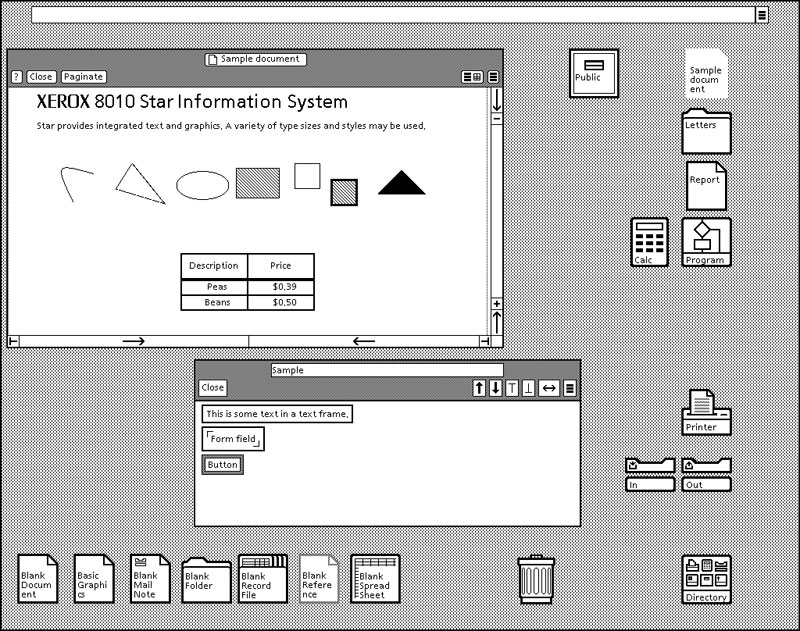
Xerox Star interface
First of all, Xerox Star was the first in the world to use file and folder icons - in almost the same form in which we later saw them in macOS and Microsoft Windows. Moreover, different icons were used for different types of documents. Windows received a different, more "advanced" design with "pseudo-three-dimensional" frames, toolbars appeared in the titles of program windows. The main paradigm of Xerox Star OS is the WYSIWYG principle - What you see is what you get. The operating system interface, as conceived by the architects, should be intuitive for any user, as opposed to the complex command line platforms that only egg-headed engineers in white coats could understand. The number of actions that could be performed on display objects with the mouse increased significantly:in addition to highlighting and dragging, the user now has the ability to act on icons and buttons by double-clicking. In addition, it was in Xerox Star that the user for the first time was able to clutter up the Desktop with arbitrary content, and not just those icons that the developers originally placed there - as was the case in Alto.

Xerox Star
Star added the Interpress markup language, which allowed the creation of documents with complex formatting, layout and integrated objects - something like what TeX now allows. In addition, for the first time in history, the user did not need to first launch the program in order to open any file in it: in Star, it was enough just to double-click on the document icon to open it in the corresponding application, which was launched automatically. For 1981, this was a real breakthrough. Another breakthrough technology inherent in the Star operating system from the very beginning is the unification of file formats. For example, a graph drawn in a diagram editor could be easily inserted into a text document, and text could be inserted into a graphic illustration.In Windows, a similar technology for linking and embedding OLE objects appeared, let's say, much later - in 1990. She worked for Xerox Star out of the box in 81st. The set of application programs has also expanded: their range has been supplemented by several engineering CAD packages, a spreadsheet editor and the previously mentioned diagram editor, as well as tools for working with databases. In general, Xerox has turned out to be a full-fledged and quite modern in its characteristics personal machine, with a windowed graphical interface and a set of applications that can satisfy even the most demanding user.a spreadsheet editor and the previously mentioned diagram editor, as well as tools for working with databases. In general, Xerox has turned out to be a full-fledged and quite modern in its characteristics personal device, with a windowed graphical interface and a set of applications that can satisfy even the most demanding user.a spreadsheet editor and the previously mentioned diagram editor, as well as tools for working with databases. In general, Xerox has turned out to be a full-fledged and quite modern in its characteristics personal device, with a windowed graphical interface and a set of applications that can satisfy even the most demanding user.

Xerox Star interface
Unfortunately, the wide expansion of Xerox Star to the market was prevented by the high price: one workplace cost customers from 16.5 to almost 50 thousand dollars, depending on the selected configuration, which, frankly, is a lot. It was in the first half of the 80s that the boom in the development of inexpensive personal computers took place: PCs from Atari, Commodore, Sinclair, RISC, IBM flooded the market. Against their background, the sophisticated but expensive Xerox Star aircraft were losing the competition catastrophically.
In 1979, Steve Jobs visited the PARC research center in Palo Alto and had some rather constructive negotiations, as a result of which Xerox got hold of Apple shares, and Jobs got access to the development of the Xerox Star operating system. The concept of this operating system formed the basis for the Macintosh platform created by Apple engineers. We still feel a distant echo of this transaction, buying devices with the logo in the form of a bitten apple on the case. After all, it is the ideas of Douglas Engelbart and specialists from Xerox, invented back in the 70s, that are our embodiment in all modern operating systems with a graphical window interface.
